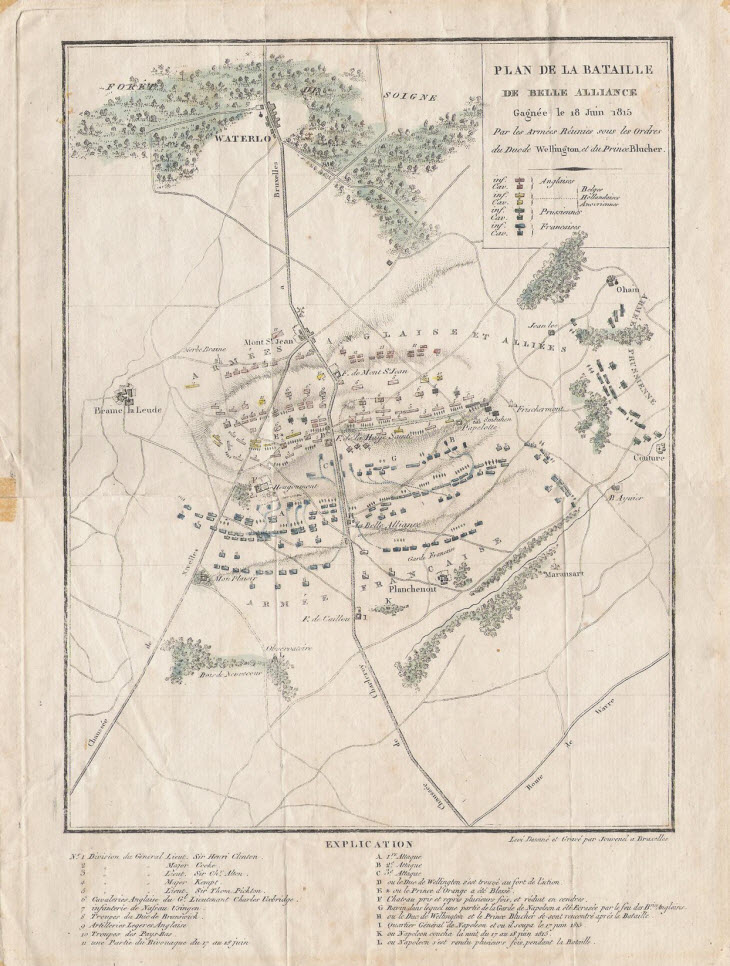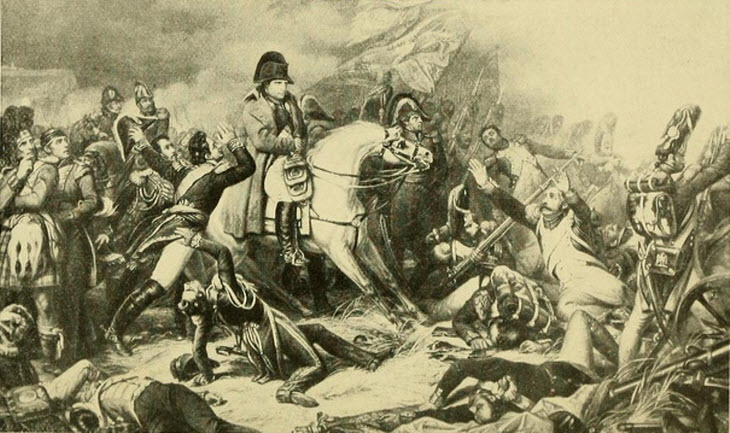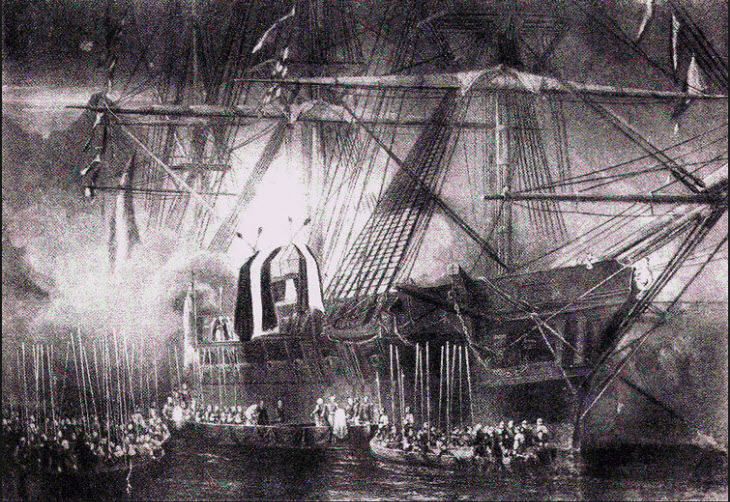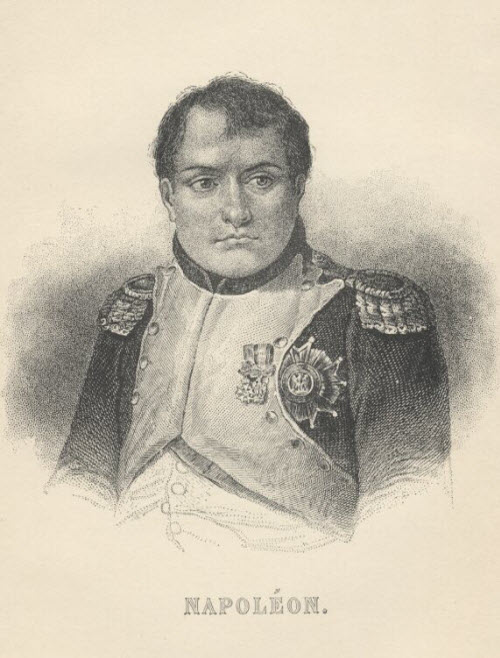The Battle of Waterloo
What Happened During the Battle
Waterloo: The Battle that Ended Napoleon's Empire
Waterloo -- Napoleon, apparently quite satisfied with what had been accomplished on the 16th, did not leave his tent at until late on the morning of the 17th. The Prussian troops, having started at about three o’clock, had already more than four hours on the march. Ziethen and Pirch their way due northward by narrow roads through and Gentinnes. while Thielruann, who had the reserves large part of the artillery and heavy wagons, took the better though longer road, through Gembloux. Bulow, who learned of his mistake in delaying at Hannut on the morning of the 10th and had hurried along the old Roman road toward Ligny, only to find himself too late, received orders early on the 17th to turn from Gembloux to Wavre. At nightfall Ziethen and Pirch had their corps safe on the north side of the Dyle at Wavre, Thielmann was on the south side, and Bulow was at Dion, 3 miles to the southeast. Gneisenau jo the course of the night sent word to Wellington of his line of retreat, but the messenger did not reach the headquarters of the duke at Quatre Bras until seven in the morning of the 17th. Wellington, on receiving assurance from Blucher that he would join him, began to fall back, and at night the 30,000 who had fought at Quatre Bras, united with about 42,000, others, slept upon the field which on the following day was to be made one of the most famous battlefields of the world.
Early in the morning of the 17th Ney sent to Napoleon for instructions. In answer to this inquiry the emperor sent a letter containing the most explicit directions. Ney was ordered to concentrate all his forces near Quatre Bras and await further orders. He added: “ To-day is required for completing this operation, filling up ammunition, and gathering stragglers and detachments.” From this it was made evident to Ney that no general engagement was intended unless the allies should assume the offensive. The emperor after sending this letter reviewed the several divisions at Bry and at Ligny, and even took the time to address the Prussian prisoners at some length. At noon, hearing that Wellington was still at Quatre Bras, he directed Soult to send another letter to Ney in which he said : “ The emperor has just placed in position before Marbais a corps of infantry and the Imperial Guard. His Majesty desires me to tell you it is his intention that you should attack the enemy at Quatre Bras and drive them from their position, and that the corps at Marbais should second your operations. His Majesty is going to Marbais and waits impatiently for your report.” It was just after sending this letter that he called Grouchy to his side and intrusted to him a force of 33,000 men and orally directed him to pursue Blucher, “ complete his defeat,” and communicate constantly with the emperor by the Namur road. Grouchy expressed himself freely as to the difficulty of finding and defeating the Prussians, who had about eight hours the start. But the emperor insisted upon the marshal’s doing his duty. At Marbais, however, Napoleon received information which shook his confidence that Blucher had gone to Namur, and sent, through the hand of Gen. Bertrand, positive instructions for Grouchy’s guidance, He was to march on Gembloux and throw out exploring parties “ to ascertain whether the Prussians were separating from the British or bent on uniting with them to save Brussels and try the fate of another battle.” This letter, written about three o’clock, probably reached Grouchy not earlier than four, at the very time when a full half of the Prussian army was north of the Dyle at Wavre. After two o’clock it rained in torrents, and it was 10 p. m. when the rear of Grouchy’s column bivouacked at Gembloux. It is worthy of note, moreover, that it was not until he reached this point that Grouchy was able to state positively that even a part of the Prussians had gone to Wavre. The reports indicated, however, that Blucher himself with one column had retired to Liege, and that one column had gone to Namur. At 2 a. m. he satisfied himself that the whole army had gone to Wavre; and accordingly, at that hour, he wrote to Napoleon that he should move in that direction early in the morning to prevent Blucher from uniting with Wellington for the protection of Brussels.
When Napoleon, leaving Marbais at about two o’clock, reached Quatre Bras, ho found that Wellington’s force had left before noon, and that Ney’s army was still resting about the crossing of the Namur and the Charleroi roads. Napoleon’s re-enforcements raised the array to 71,947 men and 340 guns. The French marched toward Waterloo and bivouacked in parallel lines only a few thousand yards from the enemy. Both armies were drenched during the night, as the downpour of rain did not cease until three or four hours after sunrise; but the French, nearly destitute of firewood, suffered more severely than the British.
Both the allies and the French were put under arms at an early hour. The French lines were drawn up in full view of the allies, and were purposely so disposed as to make the largest possible impression. The emperor went from division to division cheering the men and showing the utmost confidence in the issue of the day. Wellington was equally active. He gave his final directions to the various commanders, and then dispatched messengers to Blucher. Three contingencies were provided for: If Napoleon should attack the British right, the Prussians were to approach by way of Ohain for the purpose of meeting the two armies; if he should assault the center or the left, they were to advance by St.-Lambert and Lasne, and take the French on the right flank; if he should advance to St.-Lambert, Blucher was to meet him in front, while Wellington would attack vigorously in the rear. At half-past eleven the French began a cannonade and apparently were making preparations for an assault upon the center, but on account of the difficulty of moving the guns Napoleon decided to delay the forward movement until one o’clock. Before the advance began the head of Bullow’s column had been a full hour in sight on the heights of St.-Lambert. Wellington knew that these were Prussians, but Napoleon could not be sure whether they were Prussians or Frenchmen.

But where was Grouchy? Leaving Gembloux at about the same hour that Blucher left Wavre, the head of his column under Vandamme had reached Nil St. Vincent, and Grouchy himself had reached Sart-les-Walhain, when, at half-past eleven, the roar of artillery in the west announced that the battle had begun. Napoleon had ordered Grouchy to find Blucher and follow him. The question now arose whether he should carry out his orders strictly or, on hearing the cannonade, wheel to the left, and by crossing the Dyle near Mousty attempt either to arrest the Prussians or to push on with all possible speed to Planchenoit. The question was discussed by Grouchy and his officers, some of whom warmly urged the latter movement. But the head of the column was 14 miles from Planchenoit, they would have for most of the way only a single narrow road, the mud was so deep that all movements must be exceedingly slow, the general of artillery protested that it would be impossible to reach the battle-field in time to be of assistance that day, and Grouchy decided to continue his inarch on Wavre. Whether he was right in this decision has been a matter of almost endless controversy among military critics. The head of Grouchy’s column after the utmost endeavors did not reach Wavre until after two o’clock. Over a much worse road it could hardly have reached Mousty before half-past two or three. But at three the last of Bulow’s column was passing St.-Lambert, and Pirch was approaching. St. Lambert, moreover, is more than 5 miles nearer the battle-field than Mousty. From all this, it appears that it would have been impossible for Grouchy to interfere with the advance of Billow, and probably impossible to arrest Pirch. But even if he had succeeded in reaching the second of the Prussian columns, Pirch and Thielmann, with their superior numbers, would at least have kept him back, and Bulow and Ziethen would have been left to pursue their way undisturbed. In view of these facts, it is not easy to see how Grouchy could in any way have influenced the result of the battle.
The first advance ordered by Napoleon at Waterloo was on the Chateau Hougoumont, at the left of the line, for the purpose of diverting attention from the more formidable attacks soon to be made on the right and the center. But the walls had been pierced with portholes by order of Wellington, and every assault was successfully repulsed. The attacking force was increased until it numbered about 12,000 men, and so persistently and wastefully was the effort kept up that very few of this force took any part in the assault on the main line of the allies.
Napoleon’s plan was to make the main attack upon the center, for the purpose of taking possession of the high ground where the Wavre turnpike enters that from Charleroi. To prepare the way for the charge an enormous battery of seventy-eight pieces planted in front of the French lines had continued for an hour and a half to fire at a range of less than a third of a mile into the allies lying across the Pike at the junction of the Wavre road. The attack was to be made in four columns, so arranged that they were from twenty-four to twenty-seven ranks deep. This unusual arrangement proved to be unwieldy, and when the assault came tended only to confusion. The charge was led by d'Erlon and at first swept everything before it. The Dutch-Belgian brigade fell back in confusion. The French reached the crest of the ridge, when Pieton’s division received them with so hot a fire, and then charged them with so much vigor that they were arrested and staggered. While they were trying to disengage their ranks Ponsonby's brigade of heavy cavalry charged them furiously, and. riding down between the columns, cut down the infantry right and left with such fury that the French, leaving two eagles and fifteen guns in the hands of the British, were obliged to withdraw in confusion. It was at this moment that Napoleon saw the Prussians approaching in such mass as to require his immediate attention. He decided to send the Sixth Corps to hold Blucher in check beyond Planchenoit. This necessity weakened his attacking line by about 16,000 men, making bis available force now some 6,000 less than Wellington's.
The next movement was a reckless assault upon the farmhouse at La Haye Sainte, the walls of which were defended with the same vigor that had characterized the defense of Hougoumont. After vast numbers of officers and men had been sacrificed, the place was taken just before four o’clock. Napoleon now thought it necessary to give his own attention to the Prussians, who were striking at his flank and rear 1 1/2 miles away. Meanwhile it had been decided to make the next great assault on the west of the Brussels pike. It was therefore determined to make the advance with cavalry. From four o’clock until six, Ney hurled the magnificent divisions of Milhaud, Lefevre-Desnouettes, Kellermann, and Guyot in four successive assaults upon the British squares, but could not break through the lines.
While these events were going on Napoleon himself was occupied in defending his flank and rear against Bullow at Planchenoit. The Prussians drove back the Sixth Corps and took possession of the village; but the emperor, believing that his flank should be defended at all hazards, called in strong reenforcements from the Old, the Middle, and the Young Guard, the very elite of the army. With the help of these he retook the town, and then, thinking the line was safe, returned to witness the results of Ney’s charge.

It was now seven o’clock, and Pirch was only 2 miles in the rear of Bulow. Ney, having no control over the Guard, had exhausted his resources, and an hour of lull gave Wellington time to reform his line.
The emperor now had before him the hard task of bringing his force into order for a final attempt to break the enemy's center. There were but eight battalions remaining that could be used against the allies. These, with such artillery as could be maneuvered for their support, were drawn up just at the left of the Brussels pike, And, after being addressed and appealed to by Napoleon, were given into the command of Ney. They were to advance by column diagonally across the field so as to Attack the British center.
As they advanced at quickstep, shouting Vive l'Empereur, all firing ceased. The heavy infantry, who were to receive them, lay flat upon the ground until the column was within 50 or 60 paces; Maitland’s brigade, presenting a front of 450 men, were then ordered to stand up. The French suddenly halted.
As they seemed to hesitate, Maitland’s famous brigade sprang forward with the bayonet. The charge was supported by the allies with a vigorous fire on the flanks, and the French were forced back to their own lines with great slaughter.
It was at this time that the head of Ziethen's column reached the ground. Coming from Ohain, he approached the field opposite the space which divided the contending armies. The division of Steinmetz at once wheeled into position and began a furious attack upon the French, spreading terror and confusion throughout the right wing of the array. At this juncture the duke, seeing that the battle was won, ordered an advance along the whole line. The French gave way at every point. The emperor did what he could, but the troops were everywhere too much exhausted to make any determined resistance. Only one line of retreat was open. The army was crowded into a confused mass, and the Prussian cavalry took up the pursuit with such terrific vigor that at Genappe the French abandoned 100 cannon, and from that point made no attempt to preserve even the semblance of order. The army broke into confusion, and the flying troops, throwing away every incumbrance, made their way as best they could toward Paris. Napoleon himself left the field in the center of a square "with a somber, but calm countenance, his far seeing glance probing futurity, and seeing that more than a battle had been lost on that day.” Before sunrise he reached Charleroi, on the 21st he arrived at Paris, and on the 22d he presented his abdication.
The number of casualties to the French it is impossible to determine. Charras, who studied the matter, estimates the killed, wounded, and missing at between 31,000 and 32,000. The allied armies lost in killed, wounded, and missing a total of 22,428. The losses of the British, threw half Britain into mourning.
Authorities.—The accounts of the campaign and battle written before a critical examination had been made of the dispatches were all very untrustworthy. Even the celebrated description of Thiers has been shown to abound in errors of the most fundamental and important nature. Alison's account, written from the British point of view, has also been entirely superseded. The two accounts of the campaign and battle given by Napoleon himself while at St, Helena, though important, are shown by the dispatches to abound in errors and misrepresentations. In some important points also they contradict each other. The most important modern works, written after a study not only of the original dispatches, but also of the memoirs of the officers who took part, are the following: Charras, Histoire de la Campagne de 1815; Chesney, Waterloo Lectures (London 1868; 3d ed. 1874); Clausewitz, Der Feldzug von 1815 in Frankreich; Gardner, Quatre Bras, Ligny, and Waterloo; Hooper, Waterloo, the Downfall of the First Napoleon-Kennedy, Notes on the Battle of Waterloo; Muffling, Sketch of the Battle of Waterloo; Ollech, Geschichte des Feldzuges von 1815; Quinet, Histoire de la Campagne de 1815; Siborne, History of the War in France and Belgium in 1815; and Ropes, The Campaign of Waterloo (New York, 1893). Those of Ropes, Gardner, and Chesney are the most valuable authorities in English. The fullest bibliography and the best maps are in Ropes. Gardner abounds in admirable notes, and has an interesting Appendix of “ Waterloo Poetry.” The highest value of Chesney perhaps is his merciless and irrefutable exposure of the mendacity of Napoleon, and the consequent worthlessness of such descriptions as those of Thiers and others that are founded on the emperor’s representations. C. K. Adams.
See Also: The Prelude to the Battle of Waterloo
Related Articles



